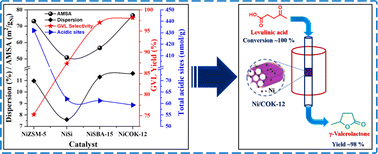Insights into structure–activity relationships in efficient silica-supported Ni catalysts for selective hydrogenation of levulinic acid†
Abstract
Upgrading biomass-derived levulinic acid (LA) with greater carbonyl (C![[double bond, length as m-dash]](https://www.rsc.org/images/entities/char_e001.gif) O) group activation is crucial in converting biomass and its derivatives into valuable biochemicals and biofuels. In the present investigation, highly dispersed Ni nanoparticle catalysts supported on various supports (HZSM-5, SiO2, SBA-15, and COK-12) were developed for the selective catalytic hydrogenation of LA to γ-valerolactone (GVL) under vapor-phase conditions. The pyridine adsorbed-FTIR profiles revealed the existence of Brønsted and Lewis acid sites. The Brønsted acidic sites are crucial for forming angelica lactones as intermediates and dehydration of 4-hydroxy valeric acid to γ-valerolactone, whereas the Lewis acidic sites are useful for the production of 4-hydroxy valeric acid as an intermediate. Electron microscopy images reveal that the NiCOK-12 catalyst exhibits a smaller particle size (TEM average particle size = 6.8 nm) than the remaining catalysts. H2-TPR and pulse chemisorption results showed the highly dispersed metallic Ni on the support and strong metal–support interaction between the metallic Ni and support matrix. Among all the synthesized catalysts, the Ni-supported COK-12 catalyst exhibited higher catalytic performance in the selective hydrogenation of LA to GVL products. The best performance of the NiCOK-12 catalyst corresponded to greater Ni dispersion, superior AMSA, ample Lewis acidic sites, smaller Ni particle size, and strong metal–support interactions. The NiCOK-12 catalyst showed more stability in the constant conversion of LA and GVL formation until 30 h of reaction time. The rationally designed earth-abundant and inexpensive catalysts in this work show controllable catalytic activity and robust stability to upgrade biomass-derived platform molecules into valuable chemicals and biofuels.
O) group activation is crucial in converting biomass and its derivatives into valuable biochemicals and biofuels. In the present investigation, highly dispersed Ni nanoparticle catalysts supported on various supports (HZSM-5, SiO2, SBA-15, and COK-12) were developed for the selective catalytic hydrogenation of LA to γ-valerolactone (GVL) under vapor-phase conditions. The pyridine adsorbed-FTIR profiles revealed the existence of Brønsted and Lewis acid sites. The Brønsted acidic sites are crucial for forming angelica lactones as intermediates and dehydration of 4-hydroxy valeric acid to γ-valerolactone, whereas the Lewis acidic sites are useful for the production of 4-hydroxy valeric acid as an intermediate. Electron microscopy images reveal that the NiCOK-12 catalyst exhibits a smaller particle size (TEM average particle size = 6.8 nm) than the remaining catalysts. H2-TPR and pulse chemisorption results showed the highly dispersed metallic Ni on the support and strong metal–support interaction between the metallic Ni and support matrix. Among all the synthesized catalysts, the Ni-supported COK-12 catalyst exhibited higher catalytic performance in the selective hydrogenation of LA to GVL products. The best performance of the NiCOK-12 catalyst corresponded to greater Ni dispersion, superior AMSA, ample Lewis acidic sites, smaller Ni particle size, and strong metal–support interactions. The NiCOK-12 catalyst showed more stability in the constant conversion of LA and GVL formation until 30 h of reaction time. The rationally designed earth-abundant and inexpensive catalysts in this work show controllable catalytic activity and robust stability to upgrade biomass-derived platform molecules into valuable chemicals and biofuels.

- This article is part of the themed collection: Sustainable Energy & Fuels Recent HOT Articles


 Please wait while we load your content...
Please wait while we load your content...